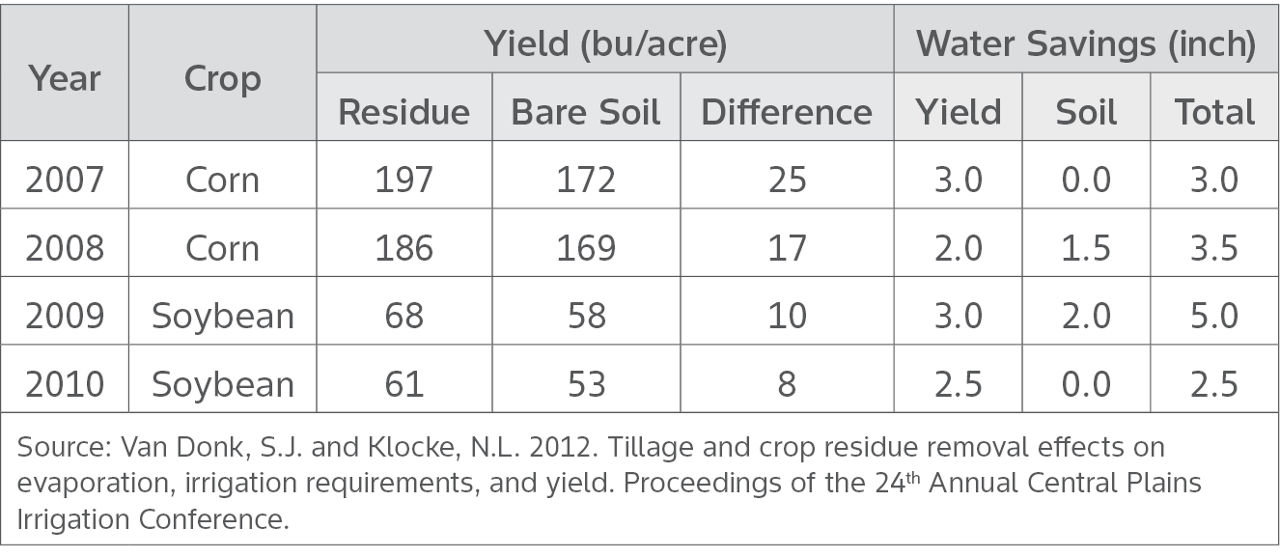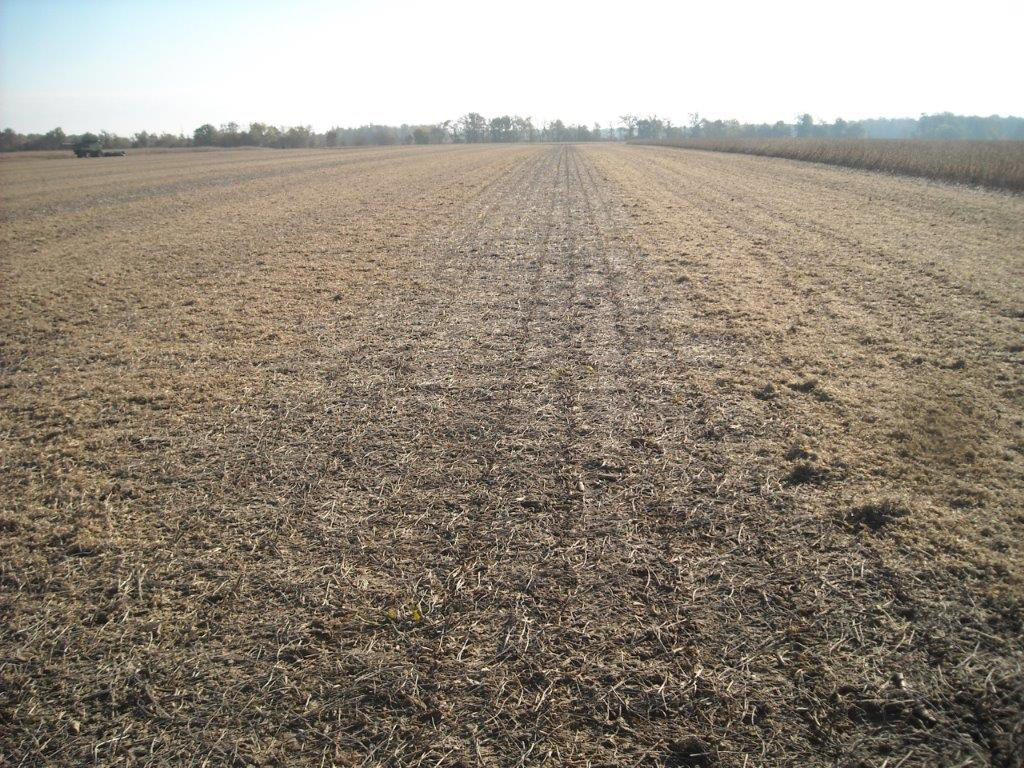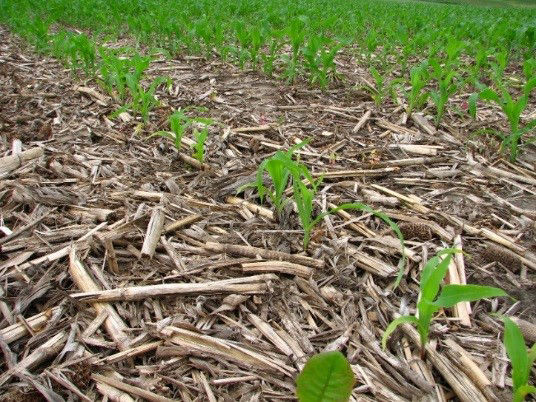7 MIN READ
Crop Residue Management
July 16, 2025
KEY POINTS
- Crop residue is a valuable resource that can help protect soil from erosion, conserve moisture, and return nutrients back to the soil.
- Residue can be managed through even spreading of plant tissue after harvest, tillage practices, or leaving the soil undisturbed.
- Crop rotation, planter adjustments, and stubble height should be considered when making residue management decisions.
Benefits of Retaining Residue
Leaving crop residue on the soil surface after harvest is an important way to help reduce soil erosion. High amounts of crop residue (more than 40 percent) can reduce soil loss from water erosion by 80 percent. Even a small amount of residue cover (10 percent) can help reduce erosion losses by 20 percent.1 Additionally, residue reduces soil moisture loss, improves soil tilth and quality, reduces nutrient runoff, and provides wildlife cover. These improvements can be related to potential yield benefits and should be considered when managing residue (Table 1).2 Conservation tillage practices resulting in greater sustainability of cropping systems are being adopted on a wider scale. This comes as the loss of crop productivity correlated to land degradation becomes a global issue.
Table 1. Comparisons of residue-covered soil and bare soil on water savings and crop yield.

Residue can be managed through harvesting adjustments and tillage; however, tillage may not be desirable in all fields. Depending on crop rotation, additional steps may help decompose residue or allow for residue management during planting of the next crop.


Crop Residue Best Management Practices
Tillage
- “Vertical” tillage, a form of conservation tillage, can help size residue while limiting soil disturbance. Vertical tillage tools cut the residue into smaller pieces for even distribution and better soil contact.
- Strip-tillage, also referred to as zone-till, leaves the soil undisturbed except for narrow strips where tillage and residue removal occurs to facilitate planting. This allows for quicker soil warming in the seed zone and helps reduce the potential for equipment-induced compaction.
- Chisel plowing can leave about 50 to 70 percent of residue (corn or small grains) on the soil surface, depending on the crop and the type of chisel plow used.3 Over the winter, 70 to 95 percent of the remaining residue is maintained. Remaining residue is reduced by 60 to 80 percent with spring cultivation. Multiplying these factors together means that an estimated 21 to 65 percent of residue remains at planting time.
Planting
- Planters equipped with row cleaners should be used to move surface residue off the seed row and enhance seed-to-soil contact in high residue management systems. Row cleaners can allow earlier soil warming and help reduce the chance of pinning residue into the seed slot. Aim for at least 30 percent residue cover after planting on a zone one-third the row-width.4
- In wet springs or if there is a lot of residue still in the field prior to planting, consider running a strip freshener approximately two to three days before planting. This can help dry out and warm up the strip where the seed will be placed by the planter. Strip freshening can help move some of the residue away from the seed slice, which might be a problem in heavy residue environments. A strip freshener, also referred to as a row freshener, can reduce the amount of residue pinning that can be a problem in high residue environments. Residue pinning in the seed slice can interrupt contact between the seed and soil which can reduce uniform germination and emergence. If a strip freshener is not available, an empty planter with row cleaners can be run across the field to move aside residue and help dry out the area where the seed will be placed.
- Soil temperatures have been shown to be a couple of degrees lower under corn residue compared to soybean residue at two inches. When planting into a growing cover crop like cereal rye, the soil temperature is even lower than under corn or soybean residue.5 Planting dates may need to be later for fields following corn, especially in high residue environments, even if measures were taken at harvest to evenly distribute residue.
- When planting into a residue level of 20 to 30 percent residue cover there is often little, or no planter or drill modifications needed.
Harvest
- For proper residue distribution, harvesters should be equipped with straw spreaders capable of uniformly distributing residue over the working width of the header.
- Chopper attachments can be adjusted to help with spreading residue the full width. Chaff spreaders attached to the rear axle are most effective for spreading wheat and soybean residues because a larger percentage of the harvested residue is managed by the cleaning shoe of the combine. If the combine does not have a chopper attachment, chopping the residue after harvest may be necessary.
- To reduce evaporative losses and to provide adequate snow retention in no-till and strip-till operations, it may be helpful to keep stubble height at a minimum of 10 inches for crops with a row spacing of less than 15 inches. For crops with a row spacing of 15 inches or greater, crop stubble height should be kept at a minimum of 15 inches. This crop stubble height should be present over at least half the field. Leaving stubble taller than 10 inches can help capture more snow and provide better insulation to plant roots.6
Residue in Continuous Corn Systems
- Consider harvesting continuous corn first to help maximize the time and availability of warmer weather, which aids microbial activity and therefore increases the decomposition of residue.
- Combine heads should be set to cut the stalks about one foot or more above the ground.
- Harvesting at this height can:
- Help reduce potential tire damage during field operations.
- Catch snow fall to increase the soil moisture to grow the next crop.
- Make it easier to plant through residue because of less loose residue on the soil surface.
- Provide wind and water erosion protection. Some heads chop the residue as it feeds through the head.7
- Corn stover can be chopped or bailed and removed from fields prior to any tillage. However, this removes phosphorus and potassium and can increase soil moisture loss and wind erosion depending on the amount of residue left after stover harvest. This can be especially important when continuous corn is grown in high yielding, no till, irrigated fields in the far western corn belt, where crop residue decomposition is often slow and can accumulate over several years.
- Spring applications of additional nitrogen (N) may depend on environmental conditions that influence microbial degradation of the residue and subsequent N release. Because residue decomposition by soil microbes is influenced by temperature, moisture and organic matter; a corn crop that is harvested late with an early planting may benefit from additional N fertilizer to replace the N that has not been released due to slow mineralization of N in the soil.
Cover Crops
- Planting cover crops after a low-residue crop like corn silage, sugar beets or potatoes have been harvested can be a valuable tool for increasing residue.
- The cover crop species planted, the seeding rate, the growing season length before winter, and if the cover crop will be grazed all will affect the amount of crop residue.
- Every crop growing area is different and there can be significant differences year-to-year depending on the fall and winter weather that can affect crop growth and management strategies. It can be helpful to work with cover crop growers from your area to find the system that works best for your crops, soils, and conditions.
- Additional N fertilizer may be required if planting a non-legume crop into a standing cereal rye cover crop (or other winter cereals) due to the high carbon to nitrogen ratio of the residue that immobilizes soil N. An additional 30 to 35 lb N/acre in a starter fertilizer may benefit early crop development. 8
Grazing
- Grazing can help manage residue, especially in areas with frozen soil during winter or in high yielding continuous corn environments. In a typical corn stalk or grain sorghum residue grazing period, cattle consume 25 to 50 percent of the available residue in 30 to 100 days, depending on stocking density.9
Measuring Residue
It may be helpful or required for conservation programs to estimate the percentage of crop residue cover. In some areas, about 12 to 20 percent residue is needed to protect flat fields from water erosion. Fields with long or steep slopes may require at least 50 to 60 percent residue cover.10 The USDA recommends using the line-transect method for estimating and reporting percent residue cover. This method involves simple field observations and measurements using a 50- to 100-foot-long measuring tape, line, or rope that can be marked at 100 equal intervals. Percent cover is determined by counting the number of marks that lie directly over a piece of residue when the rope or line is placed at a 45° angle to the rows. For complete details on the line-transect method and worksheets for reporting percent residue cover please refer to the USDA National Agronomy Manual (pages: 503-126 to 503-127) found at NRCS National Agronomy Manual.11
For a more general estimate of crop residue cover, when reporting is not necessary, the photo-comparison method can be used. This involves comparing sections of the field that are representative of typical residue cover throughout the field and comparing them to photographs of known percentage cover.11
Conclusion
Harvest and planting are the most important times to focus on crop residue management, especially in minimum-till or no-till cropping systems. Understanding the benefits of leaving residue on the soil surface has led farmers to use less aggressive tillage. Additional residue management options may be necessary in continuous corn systems.
Sources:
1 Shelton, D.P., and Jasa, P.J. 2009. Estimating percent residue cover using the line-transect method. University of Nebraska-Lincoln. NebGuide G1931. https://extensionpubs.unl.edu/publication/g1931/2009/html/view.
2 Van Donk, S.J. and Klocke, NL. 2012. Tillage and crop residue removal effects on evaporation, irrigation requirements, and yield. West Central Research and Extension Center, North Platte. 62. https://digitalcommons.unl.edu/cgi/viewcontent.cgi?article=1062&context=westcentresext.
3 Jasa, P.J. Chisel. University of Nebraska-Lincoln. Institute of Agriculture and Natural Resources. CropWatch. https://cropwatch.unl.edu/tillage/chisel/.
4 Al-Kaisi, M. 2001. Plan for 2002 residue before harvest. Iowa State University. Extension and Outreach. Integrated Crop Management. https://crops.extension.iastate.edu/encyclopedia/plan-2002-residue-harvest.
5 Brhel, J., and Specht, J. 2021. Tracking Soil and Air Temperatures — Soybean Planting Considerations. University of Nebraska-Lincoln. Institute of Agriculture and Natural Resources. CropWatch. https://cropwatch.unl.edu/2021/tracking-soil-and-air-temperatures-soybean-planting-considerations/.
6 2012. Residue and tillage management no till/strip till/direct seed. Ohio Natural Resources Conservation Service Conservation Practice Standard. Code 329. https://efotg.sc.egov.usda.gov/references/Delete/2015-4-18/Oh_329_Residue_and_Tillage_No_Till_Standard.pdf.
7 Jasa, P. 2009. Recommendations for managing corn residue at harvest. University of Nebraska-Lincoln. Institute of Agriculture and Natural Resources. CropWatch. https://cropwatch.unl.edu/recommendations-managing-corn-residue-harvest/.
8 Vieira Branco Ozorio, D., Basche, A., and Koehler-Cole, K. 2022. How much nitrogen does my cover crop take up and when do I get it back? University of Nebraska-Lincoln. Institute of Agriculture and Natural Resources. CropWatch. https://cropwatch.unl.edu/2020/how-much-nitrogen-does-my-cover-crop-take-and-when-do-i-get-it-back/.
9 Rasby, R. J., Drewnoski, M.E., and Stalker, A. 2014. Grazing crop residues with beef cattle. Publication EC278, University of Nebraska-Lincoln. https://extensionpubs.unl.edu/publication/ec278/2014/pdf/view/ec278-2014.pdf.
10 Al-Kaisi, M.M., and Hanna, M. 2002. Residue management & cultural practices. Iowa State University. Extension and Outreach. Resources Conservation Practices. Integrated Crop Management. PM 1901a. https://store.extension.iastate.edu/product/Residue-Management-and-Cultural-Practices-Resource-Conservation-Practices.
11 National Agronomy Manual. 2011. United State Department of Agriculture Natural Resources Conservation Service. 190-V-NAM, 4th Ed. https://www.nrcs.usda.gov/sites/default/files/2022-10/National-Agronomy-Manual.pdf.
1017_156547